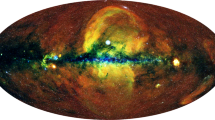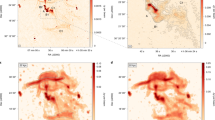Abstract
The Galactic Centre contains a supermassive black hole with a mass of four million Suns1 within an environment that differs markedly from that of the Galactic disk. Although the black hole is essentially quiescent in the broader context of active galactic nuclei, X-ray observations have provided evidence for energetic outbursts from its surroundings2. Also, although the levels of star formation in the Galactic Centre have been approximately constant over the past few hundred million years, there is evidence of increased short-duration bursts3, strongly influenced by the interaction of the black hole with the enhanced gas density present within the ring-like central molecular zone4 at Galactic longitude |l| < 0.7 degrees and latitude |b| < 0.2 degrees. The inner 200-parsec region is characterized by large amounts of warm molecular gas5, a high cosmic-ray ionization rate6, unusual gas chemistry, enhanced synchrotron emission7,8, and a multitude of radio-emitting magnetized filaments9, the origin of which has not been established. Here we report radio imaging that reveals a bipolar bubble structure, with an overall span of 1 degree by 3 degrees (140 parsecs × 430 parsecs), extending above and below the Galactic plane and apparently associated with the Galactic Centre. The structure is edge-brightened and bounded, with symmetry implying creation by an energetic event in the Galactic Centre. We estimate the age of the bubbles to be a few million years, with a total energy of 7 × 1052 ergs. We postulate that the progenitor event was a major contributor to the increased cosmic-ray density in the Galactic Centre, and is in turn the principal source of the relativistic particles required to power the synchrotron emission of the radio filaments within and in the vicinity of the bubble cavities.
This is a preview of subscription content, access via your institution
Access options
Access Nature and 54 other Nature Portfolio journals
Get Nature+, our best-value online-access subscription
$29.99 / 30 days
cancel any time
Subscribe to this journal
Receive 51 print issues and online access
$199.00 per year
only $3.90 per issue
Buy this article
- Purchase on Springer Link
- Instant access to full article PDF
Prices may be subject to local taxes which are calculated during checkout


Similar content being viewed by others
Data availability
The data that support the findings of this study are available from a corresponding author upon reasonable request.
References
Gillessen, S. et al. An update on monitoring stellar orbits in the Galactic Center. Astrophys. J. 837, 30 (2017).
Ponti, G., Terrier, R., Goldwurm, A., Belanger, G. & Trap, G. Discovery of a superluminal Fe K echo at the Galactic Center: the glorious past of Sgr A* preserved by molecular clouds. Astrophys. J. 714, 732–747 (2010).
Genzel, R., Eisenhauer, F. & Gillessen, S. The Galactic Center massive black hole and nuclear star cluster. Rev. Mod. Phys. 82, 3121–3195 (2010).
Sormani, M. C. et al. A theoretical explanation for the Central Molecular Zone asymmetry. Mon. Not. R. Astron. Soc. 475, 2383–2402 (2018).
Huettemeister, S., Wilson, T. L., Bania, T. M. & Martin-Pintado, J. Kinetic temperatures in Galactic Center molecular clouds. Astron. Astrophys. 280, 255–267 (1993).
Oka, T., Geballe, T. R., Goto, M., Usuda, T. & McCall, B. J. Hot and diffuse clouds near the Galactic Center probed by metastable H+ 3. Astrophys. J. 632, 882–893 (2005).
Sofue, Y. & Handa, T. A radio lobe over the Galactic Centre. Nature 310, 568–569 (1984).
Law, C. J. A multiwavelength view of a mass outflow from the Galactic Centre. Astrophys. J. 708, 474–484 (2010).
Yusef-Zadeh, F., Morris, M. & Chance, D. Large, highly organized radio structures near the Galactic Centre. Nature 310, 557–561 (1984).
Camilo, F. et al. Revival of the magnetar PSR J1622–4950: observations with MeerKAT, Parkes, XMM-Newton, Swift, Chandra, and NuSTAR. Astrophys. J. 856, 180 (2018).
Law, C. J., Backer, D., Yusef-Zadeh, F. & Maddalena, R. Radio recombination lines toward the Galactic Center Lobe. Astrophys. J. 695, 1070–1081 (2009).
Wardle, M. & Yusef-Zadeh, F. On the origin of the central 1″ hole in the stellar disk of Sgr A* and the Fermi gamma-ray bubbles. Astrophys. J. 787, L14 (2014).
Su, M., Slatyer, T. R. & Finkbeiner, D. P. Giant gamma-ray bubbles from Fermi-LAT: Active Galactic Nucleus activity or bipolar Galactic wind? Astrophys. J. 724, 1044–1082 (2010).
Carretti, E. et al. Giant magnetized outflows from the centre of the Milky Way. Nature 493, 66–69 (2013).
Yang, H.-Y. K., Ruszkowski, M. & Zweibel, E. The Fermi bubbles: gamma-ray, microwave, and polarization signatures of leptonic AGN jets. Mon. Not. R. Astron. Soc. 436, 2734–2746 (2013).
Crocker, R. M. & Aharonian, F. Fermi bubbles: giant, multibillion-year-old reservoirs of Galactic Center cosmic rays. Phys. Rev. Lett. 106, 101102 (2011).
Nakashima, S. et al. Discovery of the recombining plasma in the south of the Galactic Center: a relic of the past Galactic Center activity? Astrophys. J. 773, 20 (2013).
Ponti, G. et al. An X-ray chimney extending hundreds of parsecs above and below the Galactic Centre. Nature 567, 347–350 (2019).
Le Petit, F. et al. Physical conditions in the central molecular zone inferred by H3 +. Astron. Astrophys. 585, A105 (2016).
Everett, J. E., Schiller, Q. G. & Zweibel, E. G. Synchrotron constraints on a hybrid cosmic-ray and thermally driven Galactic wind. Astrophys. J. 711, 13–24 (2010).
Blasi, P. Cosmic ray acceleration in supernova remnants. In Cosmic Rays for Particle and Astroparticle Physics (eds Giani, S., Leroy, C. & Rancoita, P. G.) 493–506 (World Scientific, 2011).
Yusef-Zadeh, F., Hewitt, J. W. & Cotton, W. A. 20 centimeter survey of the Galactic Center region. I. Detection of numerous linear filaments. Astrophys. J. Suppl. Ser. 155, 421–550 (2004).
LaRosa, T. N., Nord, M. E., Lazio, T. J. W. & Kassim, N. E. New nonthermal filaments at the Galactic Center: are they tracing a globally ordered magnetic field? Astrophys. J. 607, 302–308 (2004).
Gray, A. D., Nicholls, J., Ekers, R. D. & Cram, L. E. Multifrequency radio studies of G359.1–00.2. Astrophys. J. 448, 164–178 (1995).
Morris, M. What are the radio filaments near the Galactic Center? In Unsolved Problems of the Milky Way (eds Blitz, L. & Teuben, P.) 247–261 (Proc. IAU Symp. 169, Kluwer, 1996).
Linden, T., Hooper, D. & Yusef-Zadeh, F. Dark matter and synchrotron emission from Galactic Center radio filaments. Astrophys. J. 741, 95 (2011).
Crocker, R. M., Bicknell, G. V., Taylor, A. M. & Carretti, E. A unified model of the Fermi bubbles, microwave haze, and polarized radio lobes: reverse shocks in the Galactic Center’s giant outflow. Astrophys. J. 808, 107 (2015).
Di Teodoro, E. M. et al. Blowing in the Milky Way wind: neutral hydrogen clouds tracing the Galactic nuclear outflow. Astrophys. J. 855, 33 (2018).
Offringa, A. et al. WSCLEAN: an implementation of a fast, generic wide-field imager for radio astronomy. Mon. Not. R. Astron. Soc. 444, 606–619 (2014).
Offringa, A. & Smirnov, O. M. An optimized algorithm for multi-scale wideband deconvolution of radio astronomical images. Mon. Not. R. Astron. Soc. 471, 301–316 (2017).
Kenyon, J. S., Smirnov, O. M., Grobler, T. L. & Perkins, S. J. CUBICAL – fast radio interferometric calibration suite exploiting complex optimization. Mon. Not. R. Astron. Soc. 478, 2399–2415 (2018).
Parker, Q. A. et al. The Macquarie/AAO/Strasbourg Hα planetary nebula catalogue: MASH. Mon. Not. R. Astron. Soc. 373, 79–94 (2006).
Siódmiak, N. & Tylenda, R. An analysis of the observed radio emission from planetary nebulae. Astron. Astrophys. 373, 1032–1042 (2001).
Yusef-Zadeh, F. et al. Interacting cosmic rays with molecular clouds: a Bremsstrahlung origin of diffuse high-energy emission from the inner 2° × 1° of the Galactic Center. Astrophys. J. 762, 33 (2013).
LaRosa, T. N. et al. Evidence of a weak Galactic Center magnetic field from diffuse low-frequency nonthermal radio emission. Astrophys. J. 626, L23–L27 (2005).
Condon, J. J. & Ransom, S. M. Essential Radio Astronomy 183 (Princeton Univ. Press, 2016).
Indriolo, N. et al. Herschel survey of Galactic OH+, H2O+, and H3O+: probing the molecular hydrogen fraction and cosmic-ray ionization rate. Astrophys. J. 800, 40 (2015).
Webber, W. R. A new estimate of the local interstellar energy density and ionization rate of Galactic cosmic rays. Astrophys. J. 506, 329–334 (1998).
Acknowledgements
The MeerKAT telescope is operated by the South African Radio Astronomy Observatory, which is a facility of the National Research Foundation, an agency of the Department of Science and Innovation. We acknowledge use of the Inter-University Institute for Data Intensive Astronomy (IDIA) data intensive research cloud for data processing. IDIA is a South African university partnership involving the University of Cape Town, the University of Pretoria and the University of the Western Cape. This research made use of Montage, which is funded by the US National Science Foundation under grant number ACI-1440620, and was previously funded by the National Aeronautics and Space Administration’s Earth Science Technology Office, Computation Technologies Project, under cooperative agreement number NCC5-626 between NASA and the California Institute of Technology. I.H. acknowledges support from the Oxford Hintze Centre for Astrophysical Surveys, which is funded through generous support from the Hintze Family Charitable Foundation. F.Y.-Z. is partially supported by grant AST-0807400 from the US National Science Foundation.
Author information
Authors and Affiliations
Contributions
I.H. and F.C. planned the MeerKAT observations presented here. I.H. performed the calibration and imaging of the observations. I.H. wrote the manuscript together with F.Y.-Z., F.C. and W.D.C. All other authors have contributed to one or more of the planning, design, construction, commissioning or operation of the MeerKAT radio telescope.
Corresponding authors
Ethics declarations
Competing interests
The authors declare no competing interests.
Additional information
Publisher’s note: Springer Nature remains neutral with regard to jurisdictional claims in published maps and institutional affiliations.
Peer review information Nature thanks Maria Chernyakova and Roland Crocker for their contribution to the peer review of this work.
Extended data figures and tables
Extended Data Fig. 1 Spectral-index map of the region surrounding the southern tip of the radio bubbles.
A single sub-band image at 1,123 MHz from pointing GCXS30 (see Extended Data Table 1), convolved to 30-arcsec resolution and corrected for primary-beam attenuation effects, is shown in greyscale. Overlaid upon this is a map of the spectral index, derived by fitting for this quantity through an image cube formed from five such sub-band images (see Extended Data Table 2). The spectral-index values for features that have a high signal-to-noise ratio detection in each sub-band can be reliably measured using this method, with values as indicated by the colour bar. The mean and 1σ spectral-index values for two such extended regions are marked on the map (in the format \(\bar{\alpha }\) = mean ±1σ) and are consistent with non-thermal synchrotron emission. The spectral indices of the additional compact sources marked A–E are also measured for verification purposes, with the results listed in Extended Data Table 3.
Rights and permissions
About this article
Cite this article
Heywood, I., Camilo, F., Cotton, W.D. et al. Inflation of 430-parsec bipolar radio bubbles in the Galactic Centre by an energetic event. Nature 573, 235–237 (2019). https://doi.org/10.1038/s41586-019-1532-5
Received:
Accepted:
Published:
Issue Date:
DOI: https://doi.org/10.1038/s41586-019-1532-5
This article is cited by
-
The Fermi/eROSITA bubbles: a look into the nuclear outflow from the Milky Way
The Astronomy and Astrophysics Review (2024)
-
Cosmic ray feedback in galaxies and galaxy clusters
The Astronomy and Astrophysics Review (2023)
-
Fermi and eROSITA bubbles as relics of the past activity of the Galaxy’s central black hole
Nature Astronomy (2022)
-
A GeV-TeV particle component and the barrier of cosmic-ray sea in the Central Molecular Zone
Nature Communications (2021)
-
Multi-scale feedback and feeding in the closest radio galaxy Centaurus A
Nature Astronomy (2021)
Comments
By submitting a comment you agree to abide by our Terms and Community Guidelines. If you find something abusive or that does not comply with our terms or guidelines please flag it as inappropriate.



